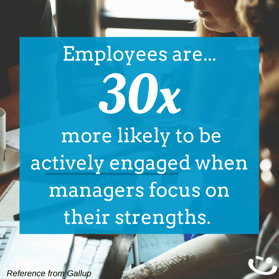.png?width=1024&name=feedback%20(1).png)
Do you truly enjoy receiving constructive criticism? Not really?
Sounds about right.
But why, then, is feedback important for your company culture? According to Gallup’s research, four out of ten workers are actively disengaged when they receive little to no feedback from their managers. When your employees are engaged, productivity is higher, turnover is lower, and your profits are positively correlated [read our Hello Doc for more].
 As you can guess, there’s a bit of a disconnect when it comes to feedback. We know we have to give and receive it, but we would prefer to procrastinate and avoid hurting anyone’s feelings. Delivering criticism is conflicting in its nature because instead of a physical altercation, the act can almost feel like an attack on someone’s sense of self.
As you can guess, there’s a bit of a disconnect when it comes to feedback. We know we have to give and receive it, but we would prefer to procrastinate and avoid hurting anyone’s feelings. Delivering criticism is conflicting in its nature because instead of a physical altercation, the act can almost feel like an attack on someone’s sense of self.
And if it doesn’t go over well, you might have scarred that person or helped to cultivate resentment against you and the organization.
Not a good situation for you, your teams, and your company.
At DH, we practice the art of feedforward [and you can too]! Feedforward is similar to feedback, but it ties closely with our core values:

Here are some major pointers on how to deliver feedforward to your teams to motivate them, create a positive space, and help them produce their best work:
 If every employee understands that constructive criticism is a part of their jobs and is meant to accelerate the business forward, then it makes it easier to swallow.
If every employee understands that constructive criticism is a part of their jobs and is meant to accelerate the business forward, then it makes it easier to swallow.
Criticism and transparency have to be practiced by leadership in order for it to take hold in the culture – and not just giving it, but receiving it as well.
The act doesn’t have to be an awkward barrage of negative comments, but you can encourage others to share their opinions with a simple question, “what do you think?” Some other easy questions to practice:
From opinion-sharing, your employees can have a healthy discussion about possible ideas and next decisions, practice the art of sharing their feedback, and cultivate a higher sense of psychological safety.
Ever heard of word vomit? I think many of us have been in that situation before – where we don’t think before we speak, and we end up saying all the wrong things. When delivering feedforward, you want your message to be clear and for your recipient to come away with a good understanding of the next steps. So take your time and breathe. It’s also very helpful to come up with a set of points you want to touch upon just in case you lose track.
Related: How to Make Your One-on-Ones with Employees More Productive
 Criticism usually focuses on the present – what someone is doing now and how they are doing it. What if you focus on their strengths and future potential instead? We don’t mean to sandwich your remarks between a bunch of compliments. That can actually be detrimental.
Criticism usually focuses on the present – what someone is doing now and how they are doing it. What if you focus on their strengths and future potential instead? We don’t mean to sandwich your remarks between a bunch of compliments. That can actually be detrimental.
What you want to do instead is to recognize the person’s strengths in being able to solve the problem or to do better next time. In fact, employers are 30x more likely to make workers actively engaged when they focus on the employees’ strengths.
An example below:
What feedback usually sounds like:
I think the strategy behind this could be better. But listen, you’re a hard worker, a leader, and really resourceful. You'll get it right next time.
What feedforward sounds like:
The strategy behind this could have benefited more from your strengths of being a hard worker, a leader, and being really resourceful. Next time you’ll be able to capitalize on that to deliver a more robust strategy.
You want your employees to leave this feedforward chat feeling like they have more to contribute to the organization and better work to do. Instead of feeling set apart from you and management, they should feel that your mutual level of honesty and respect is still intact.
Can you deliver feedforward at your organization?

Bri is the Impact Storyteller on the Delivering Happiness team. Working previously as a freelancer, her goal has always been to work with passionate people who are focused on helping individuals and businesses find their purpose. As part of DH, she now gets to accomplish that every day. Bri resides in Arizona and is lucky enough to enjoy the sun all year round.